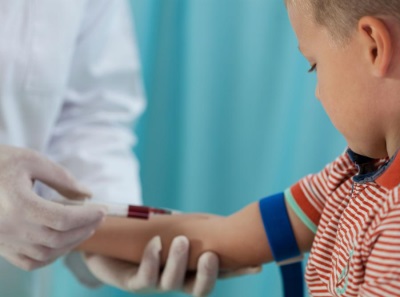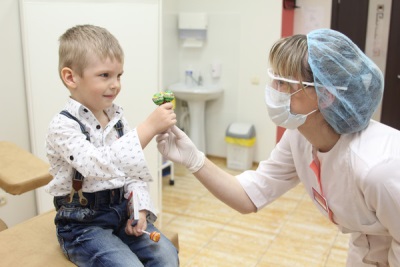Causes of a low color index of blood in a child
A blood test is prescribed to children and for prophylactic examination in order to reveal latent pathologies in time, and for various diseases in order to clarify the diagnosis or control treatment. In the form of a blood test, you can see not only the result of counting blood cells and the amount of hemoglobin, but also some other indicators, the value of which is unknown to most parents. One of them is a color indicator. Let's see why it is needed and what to do if the child has such an indicator.
What is it
Color indicator (CPU) is a parameter that is calculated using a special formula. It helps determine how much hemoglobin is inside red blood cells. The parameter suggests how red blood cells cope with their main function - the exchange of gases to provide all the cells of the child's body with oxygen and remove carbon dioxide from them.
Calculating the color indicator for children
Usually the color indicator is marked by a laboratory assistant in a blood test form, but it can also be calculated independently. To do this, you need to know:
- Red blood cell count (SE)
- Hemoglobin level (G)
To calculate, multiply G by 3 and divide by the first three digits of the SE (the comma is not taken into account). For example, red blood cells in a child 4x1012/ l, and hemoglobin - 120 g / l. Then to calculate the CPU you need (120x3): 400, and as a result we get 0.9.
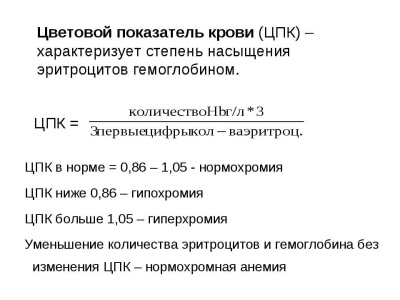
If the figure is obtained with a large number of decimal places, it is rounded up to hundredths. For example, with the number of erythrocytes 3,3x1012/ l and hemoglobin level of 95 g / l, we need (95x3): 330. The result will be 0.8636, that is, after rounding will be 0.86.
The erythrocyte index MCHC (this means the average concentration of hemoglobin in red blood cells) is a counterpart of this indicator in the modern blood test. The parameter is needed to diagnose anemia, in particular - to determine its causes and extent.
What CPU is normal in children
The normal value of the CPU affects the age of the child. In newly born babies, this figure is higher, which is associated with the presence in the bloodstream of cells with fetal hemoglobin. However, by the month the color index decreases, and in the age of one year it becomes less than one. Normal CPU is also called "normochromia."
The standard color indicator for children of different ages is:
|
Have a newborn |
1,2 |
|
In 1 month |
1,1 |
|
At the age of 1-5 years |
0,8 |
|
5-10 years old |
0,9 |
|
At the age of 10-15 years |
0,95 |
|
Older than 15 years |
1 |
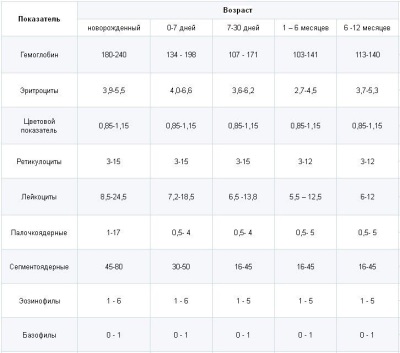
Causes of low CPU
If the child’s color index is lowered, this is called hypochromia. It is often diagnosed in violation of the formation of red blood cells and filling them with hemoglobin due to iron deficiency. At the same time in erythrocytes of normal size there may not be enough hemoglobin or the erythrocytes themselves may be smaller (they are called microcytes).
If the parameter is determined below the norm in infants, it is associated with anemia in the expectant mother during the period of gestation or with malnutrition of the nursing mother. In older children, anemia is most often triggered by an unbalanced diet, for example, if the child eats irregularly or follows a vegetarian diet.
The cause of low hemoglobin in red blood cells can be an active growth of the child or lack of physical activity, as well as a disease of the digestive system, due to which nutrients are worse absorbed.
In addition to iron deficiency anemia, the cause of lower CPU may be:
- Renal failure.
- Damage to the bone marrow, in which the formation of red blood cells is disturbed.
- Cirrhosis of the liver.
- Hemoglobinopathy.
- Malignant tumor.
- Lead poisoning.
Symptoms of lowering the CPU
If the child has low CP due to anemia, the mother will notice such manifestations of the disease as:
- Pallor of the skin and mucous membranes.
- Flaccidity and weakness, as well as the rapid appearance of fatigue during normal activity.
- Decreased appetite or desire to eat inedible, for example, chalk.
- The appearance of dizziness and frequent headaches, as well as tinnitus.
- Cold to the skin of the limbs.
- Low-grade body temperature.
- Nail fragility and deterioration of hair.
- Increased breathing and increased heart rate.
- Worse sleep
- The frequent occurrence of viral infections and colds.
What to do
Having found a reduced color index in the blood analysis of a son or daughter, one should go with the child to the pediatrician. The doctor will take into account other results of the analysis, as well as complaints, after which he will refer the child to additional studies. In most cases, the cause of low CP is anemia, so in the general analysis there will also be a reduced number of red blood cells and a reduced level of hemoglobin. However, for some babies, low CPU signifies problems with the kidneys, so the child is also sent for urinalysis and, if necessary, for an ultrasound of the kidneys.
If a decrease in the color index below the norm is detected in case of iron deficiency anemia, the pediatrician will prescribe iron supplements to the child and also advise how to correct the diet. It is important for parents to remember that only a change in diet with existing anemia does not help to cure it.
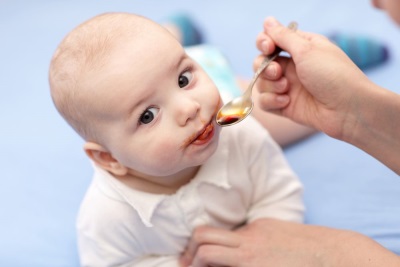
Adding foods with enough iron to the diet helps only to prevent anemia or to stop the progression of the disease. So listen to the attending physician and treat the child in accordance with its recommendations. And then the color indicator will quickly return to its normal value.
It is possible to increase hemoglobin in the blood without using pharmaceutical preparations, but with the help of traditional medicine and proper nutrition. What exactly needs to be included in the diet for anemia and other tricks of traditional medicine can be found in the following video.

